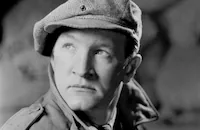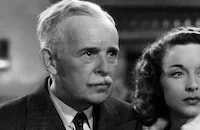Little Big Shot

Brief Synopsis
Cast & Crew
Michael Curtiz
Sybil Jason
Glenda Farrell
Robert Armstrong
Edward Everett Horton
Jack La Rue
Film Details
Technical Specs

Synopsis
Steve Craig and Mortimer Thompson are a pair of sidewalk confidence men working Broadway one step ahead of the police. Broke, they arrange to have dinner with an old friend, Gibbs, and his small daughter Gloria. Each believes the other has money. Actually, Gibbs is hiding from some gangsters, who kill him when he walks out of the restaurant, leaving Gloria with Steve and Mortimer. The men try to place Gloria in an orphanage, and when that fails, they decide to take care of her themselves with the help of Jean, a hat check girl at their hotel. Unexpectedly, Gloria's talents at impressions, singing and dancing improve their sidewalk business. Despite Jean's disapproval, things go well until gangster Jack Doré refuses to pay Steve the money he has won in a crap game. Embarrassed to seem weak in front of Gloria, Steve threatens to kill Doré, and when he is later found dead, Steve is the prime suspect. Believing that the hotel is not the right environment for Gloria, Jean has her placed in an orphanage. Another gang, however, kidnaps Gloria to force Steve out of hiding. Steve talks the criminals into releasing Gloria, and just as they are about to kill him, the police, tipped off by Mortimer and Jean, arrive at the hideout. His name cleared, Steve marries Jean, and they adopt Glora and with Mortimer, open a roadside cafe.

Director

Michael Curtiz
Cast

Sybil Jason

Glenda Farrell

Robert Armstrong

Edward Everett Horton

Jack La Rue
Arthur Vinton

J. Carroll Naish

Edgar Kennedy

Addison Richards
Emma Dunn
Tammany Young

Joseph Sauers
Eddie Shubert

Ward Bond
Murray Alper
Marc Lawrence
Guy Usher
Mary Foy
Jackie Saunders
George Humbert
Gene Morgan
Ernest Wood
Don Downen
Jesse Scott
Arvert Pott
Stuart Holmes
Burr Caruth
Gloria Fisher

Joseph Crehan
Kernan Cripps
Lee Prather
Lee Shumway
Dell Henderson

Howard C. Hickman
Milton Kibbee
Richard Powell
Georgia O'dell
Claudia Coleman
Dorothy Gray
Crew
Robert Andrews
Sam Bischoff
Frank Dixon
Julius J. Epstein
Leo F. Forbstein
Tony Gaudio
Byron Haskins
Harrison Jacobs
Jack Killifer
Frank Macdonald
Hugh Reticker
Sherry Shourds
Jerry Wald
Allie Wrubel

Film Details
Technical Specs

Articles
Little Big Shot

Little Big Shot
Marc Lawrence (1910-2005)
Born Max Goldsmith on February 17, 1910, in the Bronx, Lawrence had his heart set on a career in drama right out of high school. He enrolled at City College of New York to study theatre, and in 1930, he worked under famed stage actress Eva Le Gallienne. Anxious for a career in movies, Lawrence moved to Hollywood in 1932 and found work immediately as a contract player with Warner Bros. (an ideal studio for the actor since they specialized in crime dramas). He was cast as a heavy in his first film, If I Had a Million (1932). Although his first few parts were uncredited, Lawrence's roles grew more prominent: a sinister henchman in the Paul Muni vehicle in Dr. Socrates (1935); a conniving convict aiding Pat O'Brien in San Quentin (1937); a menacing thug stalking Dorothy Lamour in Johnny Apollo (1940); the shrewdly observant chauffeur in Alan Ladd's breakthrough hit This Gun For Hire (1942); and one of his most memorable roles as Ziggy, a fedora wearing mobster in the Bogart-Bacall noir classic Key Largo (1948).
Lawrence, when given the opportunity, could play against type: as the prosecuting attorney challenging Tyrone Power in Brigham Young (1940); a noble aristocrat in the Greer Garson-Walter Pidgeon period opus Blossoms in the Dust; and most impressively, as a deaf mute simpleton in the rustic drama The Shepherd of the Hills (both 1941). Better still was Lawrence's skill at comedy, where his deadpan toughness worked terrifically as a straight man against the likes of Joe E. Brown in Beware Spooks (1939); Abbott and Costello in Hit the Ice (1943); Penny Singleton in Life with Blondie (1945); and Bob Hope in My Favorite Spy (1951).
After that, Lawrence's career took a turn downward spin when he was labeled a communist sympathizer during the Hollywood witch hunts of the early '50s. He was exiled in Europe for a spell (1951-59), and when he came back, the film industry turned a blind eye to him, but television overcompensated for that. Here he played effective villains (what else?) in a series of crime caper programs: Peter Gunn, Johnny Staccato, The Untouchables, Richard Diamond, Private Detective; and eventually made a welcome return to the big screen as a returning exiled gangster in William Asher's underrated mob thriller Johnny Cool (1963).
It wasn't long before Lawrence found himself back in the fray playing in some big box-office hits over the next two decades: Diamonds Are Forever (1971), The Man with the Golden Gun (1974), Marathon Man (1976), Foul Play (1978); and The Big Easy (1987). Sure he was cast as a gangster, but nobody could play a rough and tumble mob boss with more style or conviction.
Interestingly, one of his finest performances in recent years was in television, as a severely ill old man unwilling to accept his fate in a fourth season episode of ER (1997-98). His last screen role was just two years ago, as a nimble minded VP in Looney Tunes: Back in Action (2003).
In 1991, Lawrence published a memoir about his venerable career, Long Time No See: Confessions of a Hollywood Gangster that received much critical acclaim. He has also developed a cult following due to his appearances in such offbeat items as From Dusk to Dawn and Pigs aka Daddy's Deadly Darling, the 1972 horror film he directed and starred in with his daughter Toni. He is survived by his wife, Alicia; two children from a previous marriage, Toni and Michael; and a stepdaughter Marina.
by Michael T. Toole
Marc Lawrence (1910-2005)
Quotes
Trivia
Byron Haskin took over as director of photography when 'Gaudio, Tony' started work on Dr. Socrates (1935).
Notes
Variety notes that this was the American screen debut of five-year-old South African Sybil Jason. She was hired by Warner Bros. to compete with Shirley Temple and Variety mentions this film's similarity to Paramount's Little Miss Marker. In the film, Jason does imitations of Greta Garbo, Mae West and Jimmy Durante. A news item in Hollywood Reporter notes that Byron Haskins finished the photography when Tony Gaudio moved on to Dr. Socrates, but only Gaudio received screen credit.
















